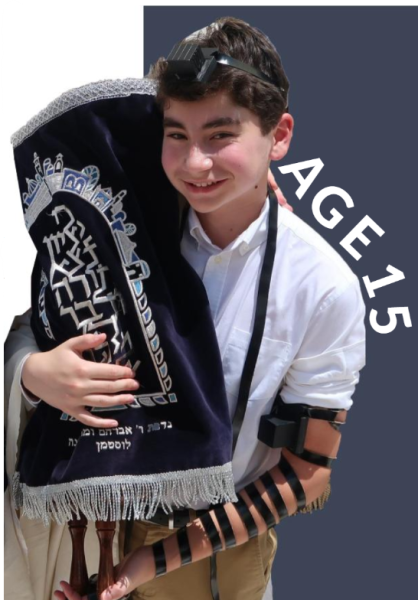At first, junior Lucia Gonzalez was hesitant to celebrate her 15th birthday with a quinceañera.
“I didn’t really have a lot of Hispanic friends […] I just thought it was a little weird and too cultural,” she said. “I didn’t want to be trying to be super Mexican, just because I’m half Mexican.”
Despite these concerns, she decided to go through with the tradition, which celebrates becoming a woman in many Latin American cultures. While the quinceanera varies across countries, the birthday girl typically wears an elaborate ball gown and invites close friends to be a part of her court. The ceremony often includes dances with relatives, godparents, damas (girls on the court) and chambelanes (boys on the court).

photo at his bar mitzvah. Delayed by the
pandemic, he took part in the tradition at age 15 rather than the typical 13. (Photo submitted by Daniel Gurvich).
Gonzalez explained the familial importance of her quince: “It’s something that every girl in my family has done […] I couldn’t have my grandparents there, so I feel like it was, in a way, like a tribute to them [and] accepting my Hispanic side,” she said.
Junior Atari Ernst also experienced family connections during his confirmation, which took place when he was in eighth grade.
“[Confirmation is when] you’re kind of getting admitted into the Catholic Church … it’s kind of like progressing your faith and becoming more mature,” he said.
Catholic rites of passage such as first communion and confirmation were incorporated into his religion class at Holy Spirit Academy. The process also involved finding external support from a sponsor who students talked to about their faith. Ernst
chose his grandpa. He described his confirmation as a “fun bonding experience,” especially because of the connections he made while interviewing his grandpa.
Bar and bat mitzvahs are another well-known exam- ple of coming-of-age celebrations, mark ing the beginning of typlcal 13. Jewish adulthood. Senior Daniel Gurvich had a unique experience with this tradition, as it was held in Israel.
“I’m a citizen, so [Israel is] kind of like home,” Gurvich said.
The pandemic delayed his bar mitzvah, so he had the celebration around his 15th birthday instead of the traditional 13. Since part of the ceremony involves memorizing a passage specific to the date of the Torah, one of the sacred Jewish texts, changing to a different calendar day would involve learning a new portion.
His takeway of the experience has evolved over time: “Not necessarily right away, but a few days later, I kind of felt something, like, changed … maybe [because of] the gravity of the moment,” he said.
Despite the differences in these traditions, Gonzalez shared the sentiment, appreciating the ways in which her quinceañera brought her closer to her family and culture.